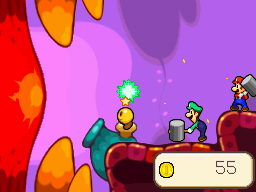There’s been a lot in gaming press, blogs, and messageboards lately about how Japanese RPGs are stagnating. With the arrival, en masse of high-quality Western RPGs on consoles, history is repeating itself. Remember what happened when console gamers discovered what good first-person shooters and built-in modding/customizing tools were like? Halo was not a big deal to those of us who had previously played everything from Wolfenstein 3D onward, and Little Big Planet looked nice, but was it really going to revolutionize things when powerful—but not overly intimidating—modding tools like UnrealEd were old news?
Anyway, like I said, there’s a lot of whining about how JRPGs have gone downhill, and some people think that the best way to fix them is to, generally, make them more Western. Such homogenization isn’t the best approach (and wouldn’t make the core JRPG consumer base happy), but what is? While some JRPG series (most notably Dragon Quest, Tales, and Pokemon) soldier on with high-quality, well-received main entries, other games have been seeking different approaches. There’ve been some novel experiments (Valkyria Chronicles, The World Ends With You), but more commonly, we’ve seen a lot of hybrids.
Hybrid RPGs are not easy to pigeonhole, and they’ve always kinda-sorta been around in one form or another, but the past few years have really seen them come into their own. For evidence of this, RPGamer’s Best of 2009 Awards is worth a look. While more traditional RPG fare took the top prizes, many genre blends popped up in other categories: SRPG/shmup Knights in the Nightmare, RPG/microgame mashup Half-Minute Hero, dungeon crawler/farming sim Rune Factory Frontier, and so on. The phenomenon isn’t limited to Japan, either, one of the more recent examples being the Western-developed puzzle RPG Might & Magic: Clash of Heroes, likewise mentioned in the Best of 2009. Clearly, RPGs mixing with other genres is a growing trend, and going by the quality of the hybrids I’ve played so far, it’s one that I personally would like to see continue.
 One of the original hybrid RPG stars has been, not unexpectedly, Mario. First in Super Mario RPG, then in the Paper Mario and Mario & Luigi games, the portly Italian plumber’s RPG adventures intermingle with the precise jumping and timing that define his platforming exploits. The Mario & Luigi series in particular adds an extra layer of challenge by having you control both Mario Bros. on the field at the same time, and eventually, special moves become available that can only be pulled off when the two are together. The second game, Partners in Time quadruples the party when Baby Mario and Baby Luigi join their older selves on the quest. This was also the first game in the series to appear on the Nintendo DS (the original was on the Game Boy Advance), occasionally reserving the top screen as the babies’ domain, with special areas only they can explore, for when they aren’t riding piggyback on the adults.
One of the original hybrid RPG stars has been, not unexpectedly, Mario. First in Super Mario RPG, then in the Paper Mario and Mario & Luigi games, the portly Italian plumber’s RPG adventures intermingle with the precise jumping and timing that define his platforming exploits. The Mario & Luigi series in particular adds an extra layer of challenge by having you control both Mario Bros. on the field at the same time, and eventually, special moves become available that can only be pulled off when the two are together. The second game, Partners in Time quadruples the party when Baby Mario and Baby Luigi join their older selves on the quest. This was also the first game in the series to appear on the Nintendo DS (the original was on the Game Boy Advance), occasionally reserving the top screen as the babies’ domain, with special areas only they can explore, for when they aren’t riding piggyback on the adults.
The latest Mario & Luigi game (and the last Mario RPG ever made that I had left to play), the Fall 2009 release Bowser’s Inside Story, is likewise on the DS, but this time, the party is reduced to three: Mario, Luigi, and perennial bad guy Bowser. The basic plot is that the Mushroom Kingdom has been hit hard by a disease called the Blorbs, which causes the local Toads to swell up into obese giants. Meanwhile, Bowser is, yet again, planning to kidnap Princess Peach when, along the way, he eats a strange mushroom which causes him to swallow up the Princess, Mario, Luigi, and half the Kingdom. Mixed in with all this is the delightfully mad Fawful, Cackletta’s henchman from the first game who comes back as a full-fledged villain here. While Mario and Luigi explore Bowser’s body to try and find a way out, Bowser commences on his own journey. What comes out of their adventures is one of the strangest symbiotic relationships the Mario canon has seen yet.
The hallmarks of the series are all present—the platforming, the special moves, the hidden items, the funny script, and so on—but a third major element has been added to the mix of RPG and Platformer: Minigames.